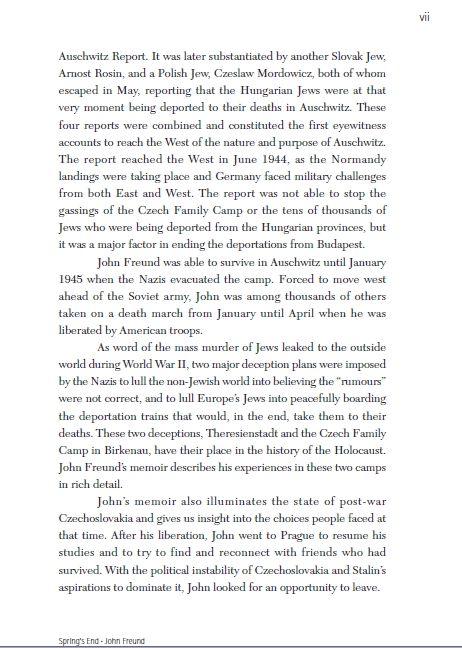 Spring's end (introduction p.VII)
Spring's end (introduction p.VII)
It was later substantiated by another Slovak Jew, Arnost Rosin, and a Polish Jew, Czeslaw Mordowicz, both of whom escaped in May, reporting that the Hungarian Jews were at that very moment being deported to their deaths in Auschwitz. These four reports were combined and constituted the first eyewitness accounts to reach the West of the nature and purpose of Auschwitz. The report reached the West in June 1944, as the Normandy landings were taking place and Germany faced military challenges from both East and West. The report was not able to stop the gassings of the Czech Family Camp or the tens of thousands of Jews who were being deported from the Hungarian provinces, but it was a major factor in ending the deportations from Budapest.
John Freund was able to survive in Auschwitz until January 1945 when the Nazis evacuated the camp. Forced to move west ahead of the Soviet army, John was among thousands of others taken on a death march from January until April when he was liberated by American troops.
As word of the mass murder of Jews leaked to the outside world duringWorldWar II, two major deception plans were imposed by the Nazis to lull the non-Jewish world into believing the “rumours” were not correct, and to lull Europe’s Jews into peacefully boarding the deportation trains that would, in the end, take them to their deaths. These two deceptions, Theresienstadt and the Czech Family Camp in Birkenau, have their place in the history of the Holocaust. John Freund’s memoir describes his experiences in these two camps in rich detail.
John’s memoir also illuminates the state of post-war Czechoslovakia and gives us insight into the choices people faced at that time. After his liberation, John went to Prague to resume his studies and to try to find and reconnect with friends who had survived. With the political instability of Czechoslovakia and Stalin’s aspirations to dominate it, John looked for an opportunity to leave.
- ‹‹
- 6 of 6